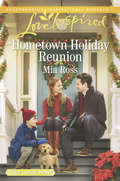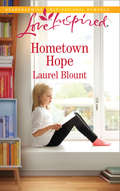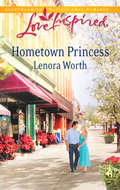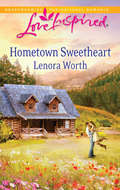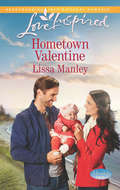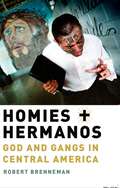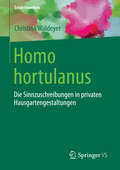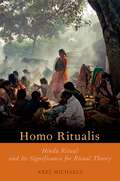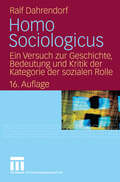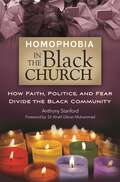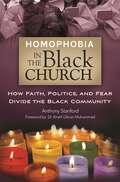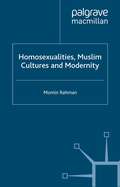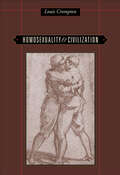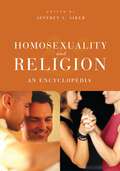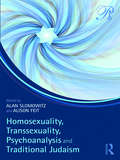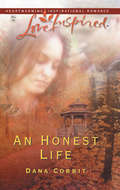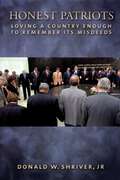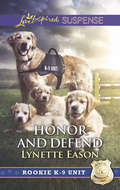- Table View
- List View
Hometown Hero's Redemption: Lone Star Bachelor Falling For The Rancher Hometown Hero's Redemption (Mills And Boon Love Inspired Ser.)
by Jill KemererA Temporary Father
Hometown Holiday Reunion: Lone Star Dad Hometown Holiday Reunion A Family For The Farmer (Oaks Crossing #3)
by Mia RossFalling for the Girl Next Door
Hometown Hope (Mills And Boon Love Inspired Ser.)
by Laurel BlountHe’ll do anything for his daughter… Even fight to regain an old classmate’s broken trust.
Hometown Princess (Mills And Boon Love Inspired Ser.)
by Lenora WorthAll Cari Duncan has ever wanted is family. Yet her late father chose his new young wife's children over Cari.
Hometown Reunion: The Wedding Quilt Bride The Rancher's Secret Child Hometown Reunion (Mills And Boon Love Inspired Ser.)
by Lisa CarterA single dad starting over Is this his second chance at love?
Hometown Sweetheart: Her Rancher Bodyguard Lakeside Sweetheart Falling For The Hometown Hero (Mills And Boon Love Inspired Ser.)
by Lenora WorthSeven unruly kids have moved next door to Simon Adams's mountain cabin. On a church retreat, these rambunctious rascals and their perky teacher, Shanna White, prove to be too much for one reclusive craftsman to handle.
Hometown Valentine: A Match For Addy Hometown Valentine Healing The Widower's Heart Big Sky Homecoming (Moonlight Cove #6)
by Lissa ManleyFinding Her Family
Homies and Hermanos: God and Gangs in Central America
by Robert BrennemanUsing the tools of sociological theory, Robert Brenneman seeks to discover why a pot-smoking, gun-wielding "homie" gang member would want to trade in la vida loca for a Bible and the buttoned-down lifestyle of an evangelical hermano (brother in Christ) - and to what extent this strategy works for the many youth who have tried it.
Homies and Hermanos: God and Gangs in Central America
by Robert BrennemanUsing the tools of sociological theory, Robert Brenneman seeks to discover why a pot-smoking, gun-wielding "homie" gang member would want to trade in la vida loca for a Bible and the buttoned-down lifestyle of an evangelical hermano (brother in Christ) - and to what extent this strategy works for the many youth who have tried it.
Homo hortulanus: Die Sinnzuschreibungen in privaten Hausgartengestaltungen (Erlebniswelten)
by Christina WaldeyerZentraler Ausgangspunkt des vorliegenden Bandes ist die Erschließung eines weitgehend unerschlossenen Themenfeldes der deutschsprachigen Soziologie: der gartensoziologische Forschungszweig. Von Interesse sind hierbei die Manifestation der Sinnzuschreibungen in der privaten Hausgartengestaltung in der Bundesrepublik Deutschland sowie die jeweiligen,mit diesen Sinnzuschreibungen verknüpften Legitimationsstrategien. Vor dem Hintergrund gesellschaftlicher Wendepunkte und Krisen wird der private Garten als Ort der Selbstbestimmung und Freiheit, als Natur und Familienidyll oder Raum technischer und kultureller Lebenswelten gedeutet. Dabei verhält sich seine Konstruktion keineswegs immer analog zum gesellschaftlichen Orientierungsrahmen. Vielmehr steht sie in einem fortwährenden Spannungsfeld zum „Nicht-Garten“ jenseits des Gartenzauns, vor dem es die eigenen Errungenschaften zu schützen gilt. Die Komplexität gärtnerischer Sinnzuschreibung vereint vielschichtige heterotope Gegensätze wie Kultur und Natur oder weltliche Gestaltung und paradiesische Idee und positioniert sich dabei stets neu zwischen Öffentlichkeit und Privatheit, bürgerlichen Traditionen und postmodernen Idealen.
HOMO RIT HIND RIT & SIGNIF RIT THEORY C: Hindu Ritual and Its Significance for Ritual Theory (Oxford Ritual Studies)
by Axel MichaelsIs the richness and diversity of rituals and celebrations in South Asia unique? Are Indians or Hindus more involved in rituals than people of other faiths and other places? If so, what makes them special? Can we speak of a homo ritualis when it comes to India or Hinduism? Drawing on extensive textual studies and fieldwork in Nepal and India, Axel Michaels demonstrates how the characteristic structure of Hindu rituals employs the Brahmanic-Sanskritic sacrifice as a model, and how this structure is one of the distinguishing features of Hinduism more generally. Many religions tend over time to develop less ritualized or more open forms of belief, but Brahmanical Hinduism has internalized ritual behavior to the extent that it has become its most important and distinctive feature, permeating social and personal life alike. The religion can thus be seen as a particular case in the history of religions in which ritual form dominates belief and develops a sweeping autonomy of ritual behavior. Homo Ritualis analyzes ritual through these cultural-specific and religious contexts, taking into account how indigenous terms and theories affect and contribute to current ritual theory. It describes and investigates various forms of Hindu rituals and festivals, such as life-cycle rituals, the Vedic sacrifice, vows processions, and the worship of deities (puja). It also examines various conceptual components of (Hindu) rituals such as framing, formality, modality, and theories of meaning.
Homo Ritualis: Hindu Ritual and Its Significance for Ritual Theory (Oxford Ritual Studies)
by Axel MichaelsIs the richness and diversity of rituals and celebrations in South Asia unique? Are Indians or Hindus more involved in rituals than people of other faiths and other places? If so, what makes them special? Can we speak of a homo ritualis when it comes to India or Hinduism? Drawing on extensive textual studies and fieldwork in Nepal and India, Axel Michaels demonstrates how the characteristic structure of Hindu rituals employs the Brahmanic-Sanskritic sacrifice as a model, and how this structure is one of the distinguishing features of Hinduism more generally. Many religions tend over time to develop less ritualized or more open forms of belief, but Brahmanical Hinduism has internalized ritual behavior to the extent that it has become its most important and distinctive feature, permeating social and personal life alike. The religion can thus be seen as a particular case in the history of religions in which ritual form dominates belief and develops a sweeping autonomy of ritual behavior. Homo Ritualis analyzes ritual through these cultural-specific and religious contexts, taking into account how indigenous terms and theories affect and contribute to current ritual theory. It describes and investigates various forms of Hindu rituals and festivals, such as life-cycle rituals, the Vedic sacrifice, vows processions, and the worship of deities (puja). It also examines various conceptual components of (Hindu) rituals such as framing, formality, modality, and theories of meaning.
Homo Sociologicus: Ein Versuch zur Geschichte, Bedeutung und Kritik der Kategorie der sozialen Rolle
by Ralf DahrendorfDer "Homo Sociologicus" ist einer der wichtigsten und einflussreichsten sozialwissenschaftlichen Texte der letzten 50 Jahre. Zur Neuauflage ist ein neues Vorwort von Lord Ralf Dahrendorf angefügt.
Homonegativity and Religiously Motivated Political Extremism: A Study Based on World Values Survey Data from 88 Countries and Territories (SpringerBriefs in Political Science)
by Arno TauschThis open access book describes the world’s increasingly multicultural societies face the problem that more and more diverse lifestyles (LGBTQIA+ communities) are not universally accepted, and that today, in addition to xenophobia, racism and anti-Semitism, there is substantial homonegativity. This book explores this issue, reviews the empirical literature on the subject and provides new empirically based evidence on a global and European scale. Based on an analysis of The World Values Survey using the statistical software SPSS, it provides a scientifically sound answer to the question of which social groups in Europe and around the globe are more homophobic and which are less, together with insights into the multivariate relationships between homonegativity and religiously motivated political extremism. The extensive and representative statistical samples allow cautious conclusions to be drawn for smaller religious groups in the European Union and other countries around the world.
Homophobia in the Black Church: How Faith, Politics, and Fear Divide the Black Community
by Anthony StanfordThis book explains how faith, politics, and fear contribute to the homophobic mindset within the Black Church and the African American community.Homophobia in the Black Church: How Faith, Politics, and Fear Divide the Black Community explores the various reasons for the Black Church's aversion—and the general black cultural inflexibility—toward homosexuality, same-sex marriage, and acceptance of the LGBT community. It connects black cultural resistance toward homosexuality to politics, faith, and fear; follows the trail of faith-based funding to the pulpit of black mega-churches; and spotlights how members of the black clergy have sacrificed black LGBTQ Christians for personal and political advancement.The author systematically builds his case, linking the reasons blacks are intolerant of deviation from acceptable sexual behavior to the 1960s struggle for racial equality, and tying longstanding black sexual mores to present day politics, social conservatism, and the lure of federal funding to black churches and religious and social organizations. He also spotlights specific homophobic black ministers and draws back the curtain on their alliance with White social conservatives and religious and political extremists to reveal an improbable but powerful union.
Homophobia in the Black Church: How Faith, Politics, and Fear Divide the Black Community
by Anthony StanfordThis book explains how faith, politics, and fear contribute to the homophobic mindset within the Black Church and the African American community.Homophobia in the Black Church: How Faith, Politics, and Fear Divide the Black Community explores the various reasons for the Black Church's aversion—and the general black cultural inflexibility—toward homosexuality, same-sex marriage, and acceptance of the LGBT community. It connects black cultural resistance toward homosexuality to politics, faith, and fear; follows the trail of faith-based funding to the pulpit of black mega-churches; and spotlights how members of the black clergy have sacrificed black LGBTQ Christians for personal and political advancement.The author systematically builds his case, linking the reasons blacks are intolerant of deviation from acceptable sexual behavior to the 1960s struggle for racial equality, and tying longstanding black sexual mores to present day politics, social conservatism, and the lure of federal funding to black churches and religious and social organizations. He also spotlights specific homophobic black ministers and draws back the curtain on their alliance with White social conservatives and religious and political extremists to reveal an improbable but powerful union.
Homosexualities, Muslim Cultures and Modernity (Palgrave Politics of Identity and Citizenship Series)
by M. RahmanThis book addresses the increasing role of queer politics within forms of Islamophobia, both by exploring the framing of lesbian, gay, bisexual, and transgender (LGBT) issues as a key marker of western superiority and by identifying the ways in which Muslim homophobia contributes to this dialectic.
Homosexuality and Civilization
by Louis CromptonHow have major civilizations of the last two millennia treated people who were attracted to their own sex? In a narrative tour de force, Louis Crompton chronicles the lives and achievements of homosexual men and women alongside a darker history of persecution, as he compares the Christian West with the cultures of ancient Greece and Rome, Arab Spain, imperial China, and pre-Meiji Japan. Ancient Greek culture celebrated same-sex love in history, literature, and art, making high claims for its moral influence. By contrast, Jewish religious leaders in the sixth century B.C.E. branded male homosexuality as a capital offense and, later, blamed it for the destruction of the biblical city of Sodom. When these two traditions collided in Christian Rome during the late empire, the tragic repercussions were felt throughout Europe and the New World. Louis Crompton traces Church-inspired mutilation, torture, and burning of “sodomites” in sixth-century Byzantium, medieval France, Renaissance Italy, and in Spain under the Inquisition. But Protestant authorities were equally committed to the execution of homosexuals in the Netherlands, Calvin’s Geneva, and Georgian England. The root cause was religious superstition, abetted by political ambition and sheer greed. Yet from this cauldron of fears and desires, homoerotic themes surfaced in the art of the Renaissance masters—Donatello, Leonardo, Michelangelo, Sodoma, Cellini, and Caravaggio—often intertwined with Christian motifs. Homosexuality also flourished in the court intrigues of Henry III of France, Queen Christina of Sweden, James I and William III of England, Queen Anne, and Frederick the Great. Anti-homosexual atrocities committed in the West contrast starkly with the more tolerant traditions of pre-modern China and Japan, as revealed in poetry, fiction, and art and in the lives of emperors, shoguns, Buddhist priests, scholars, and actors. In the samurai tradition of Japan, Crompton makes clear, the celebration of same-sex love rivaled that of ancient Greece. Sweeping in scope, elegantly crafted, and lavishly illustrated, Homosexuality and Civilization is a stunning exploration of a rich and terrible past.
Homosexuality and Religion: An Encyclopedia
by Jeffrey S. SikerFew issues today cause more public - and private - debate than the interaction of homosexuality and religion. From the question of gay marriage to the place of gays and lesbians within faith communities, religious leaders and lay members must deal with these issues for now and for years to come. What is the historical position of the major denominations? How are people of faith balancing their beliefs? This encyclopedia provides an overview of the various attitudes and responses that religions have had to the presence of gay, lesbian, bisexual, and transgendered persons within their communities. This is the most comprehensive volume to date on the intersections between religion and homosexuality.
Homosexuality, Transsexuality, Psychoanalysis and Traditional Judaism (Psychoanalysis in a New Key Book Series)
by Alan Slomowitz Alison FeitHomosexuality, Transsexuality, Psychoanalysis and Traditional Judaism explores the often incommensurable and irreconcilable beliefs and understandings of sexuality and gender in the Orthodox Jewish community from psychoanalytic, rabbinic, feminist, and queer perspectives. The book explores how seemingly irreconcilable differences might be resolved. The book is divided into two separate but related sections. The first highlights the divide between the psychoanalytic, academic, and traditional Orthodox Jewish perspectives on sexual identity and orientation, and the acute psychic and social challenges faced by gay and lesbian members of the Orthodox Jewish world. The contributors ask us to engage with them in a dialogue that allows for authentic conversation. The second section focuses on gender identity, especially as experienced by the Orthodox transgender members of the community. It also highlights the divide between theories that see gender as fluid and traditional Judaism that sees gender as strictly binary. The contributors write about their views and experiences from both sides of the divide. They ask us to engage in true authentic dialogue about these complex and crucial emotional and religious challenges. Homosexuality, Transsexuality, Psychoanalysis and Traditional Judaism will be of great interest to psychoanalysts and psychoanalytic psychotherapists as well as members and leaders of Jewish communities working with LGBTQ issues.
Homosexuality, Transsexuality, Psychoanalysis and Traditional Judaism (Psychoanalysis in a New Key Book Series)
by Alan Slomowitz Alison FeitHomosexuality, Transsexuality, Psychoanalysis and Traditional Judaism explores the often incommensurable and irreconcilable beliefs and understandings of sexuality and gender in the Orthodox Jewish community from psychoanalytic, rabbinic, feminist, and queer perspectives. The book explores how seemingly irreconcilable differences might be resolved. The book is divided into two separate but related sections. The first highlights the divide between the psychoanalytic, academic, and traditional Orthodox Jewish perspectives on sexual identity and orientation, and the acute psychic and social challenges faced by gay and lesbian members of the Orthodox Jewish world. The contributors ask us to engage with them in a dialogue that allows for authentic conversation. The second section focuses on gender identity, especially as experienced by the Orthodox transgender members of the community. It also highlights the divide between theories that see gender as fluid and traditional Judaism that sees gender as strictly binary. The contributors write about their views and experiences from both sides of the divide. They ask us to engage in true authentic dialogue about these complex and crucial emotional and religious challenges. Homosexuality, Transsexuality, Psychoanalysis and Traditional Judaism will be of great interest to psychoanalysts and psychoanalytic psychotherapists as well as members and leaders of Jewish communities working with LGBTQ issues.
An Honest Life (Mills And Boon Love Inspired Ser.)
by Dana CorbitA preacher. A deacon. That was the kind of man nurse Charity Sims planned to marry. Which is why her lovesick behavior around Rick McKinley, the contractor building a family center for her church, so confused her. He refused to go to church, let alone lead one. So what if he was handsome and charming? They couldn' t be more different.
Honest Patriots: Loving a Country Enough to Remember Its Misdeeds
by Donald W. ShriverIn Honest Patriots, renowned public theologian and ethicist Donald W. Shriver, Jr. argues that we must acknowledge and repent of the morally negative events in our nation's past. The failure to do so skews the relations of many Americans to one another, breeds ongoing hostility, and damages the health of our society. Yet our civic identity today largely rests on denials, forgetfulness, and inattention to the memories of neighbors whose ancestors suffered great injustices at the hands of some dominant majority. Shriver contends that repentance for these injustices must find a place in our political culture. Such repentance must be carefully and deliberately cultivated through the accurate teaching of history, by means of public symbols that embody both positive and negative memory, and through public leadership to this end. Religious people and religious organizations have an important role to play in this process. Historically, the Christian tradition has concentrated on the personal dimensions of forgiveness and repentance to the near-total neglect of their collective aspects. Recently, however, the idea of collective moral responsibility has gained new and public visibility. Official apologies for past collective injustice have multiplied, along with calls for reparations. Shriver looks in detail at the examples of Germany and South Africa, and their pioneering efforts to foster and express collective repentance. He then turns to the historic wrongs perpetrated against African Americans and Native Americans and to recent efforts by American citizens and governmental bodies to seek public justice by remembering public injustice. The call for collective repentance presents many challenges: What can it mean to morally master a past whose victims are dead and whose sufferings cannot be alleviated? What are the measures that lend substance to language and action expressing repentance? What symbolic and tangible acts produce credible turns away from past wrongs? What are the dynamics-psychological, social, and political-whereby we can safely consign an evil to the past? How can public life witness to corporate crimes of the past in such a way that descendents of victims can be confident that they will never be repeated? In his provocative answers to these questions Shriver creates a compelling new vision of the collective repentance and apology that must precede real progress in relations between the races in this country.
Honest Patriots: Loving a Country Enough to Remember Its Misdeeds
by Donald W. ShriverIn Honest Patriots, renowned public theologian and ethicist Donald W. Shriver, Jr. argues that we must acknowledge and repent of the morally negative events in our nation's past. The failure to do so skews the relations of many Americans to one another, breeds ongoing hostility, and damages the health of our society. Yet our civic identity today largely rests on denials, forgetfulness, and inattention to the memories of neighbors whose ancestors suffered great injustices at the hands of some dominant majority. Shriver contends that repentance for these injustices must find a place in our political culture. Such repentance must be carefully and deliberately cultivated through the accurate teaching of history, by means of public symbols that embody both positive and negative memory, and through public leadership to this end. Religious people and religious organizations have an important role to play in this process. Historically, the Christian tradition has concentrated on the personal dimensions of forgiveness and repentance to the near-total neglect of their collective aspects. Recently, however, the idea of collective moral responsibility has gained new and public visibility. Official apologies for past collective injustice have multiplied, along with calls for reparations. Shriver looks in detail at the examples of Germany and South Africa, and their pioneering efforts to foster and express collective repentance. He then turns to the historic wrongs perpetrated against African Americans and Native Americans and to recent efforts by American citizens and governmental bodies to seek public justice by remembering public injustice. The call for collective repentance presents many challenges: What can it mean to morally master a past whose victims are dead and whose sufferings cannot be alleviated? What are the measures that lend substance to language and action expressing repentance? What symbolic and tangible acts produce credible turns away from past wrongs? What are the dynamics-psychological, social, and political-whereby we can safely consign an evil to the past? How can public life witness to corporate crimes of the past in such a way that descendents of victims can be confident that they will never be repeated? In his provocative answers to these questions Shriver creates a compelling new vision of the collective repentance and apology that must precede real progress in relations between the races in this country.
Honor And Defend: Seek And Find Honor And Defend (Rookie K-9 Unit #4)
by Lynette EasonA PERILOUS REUNION

